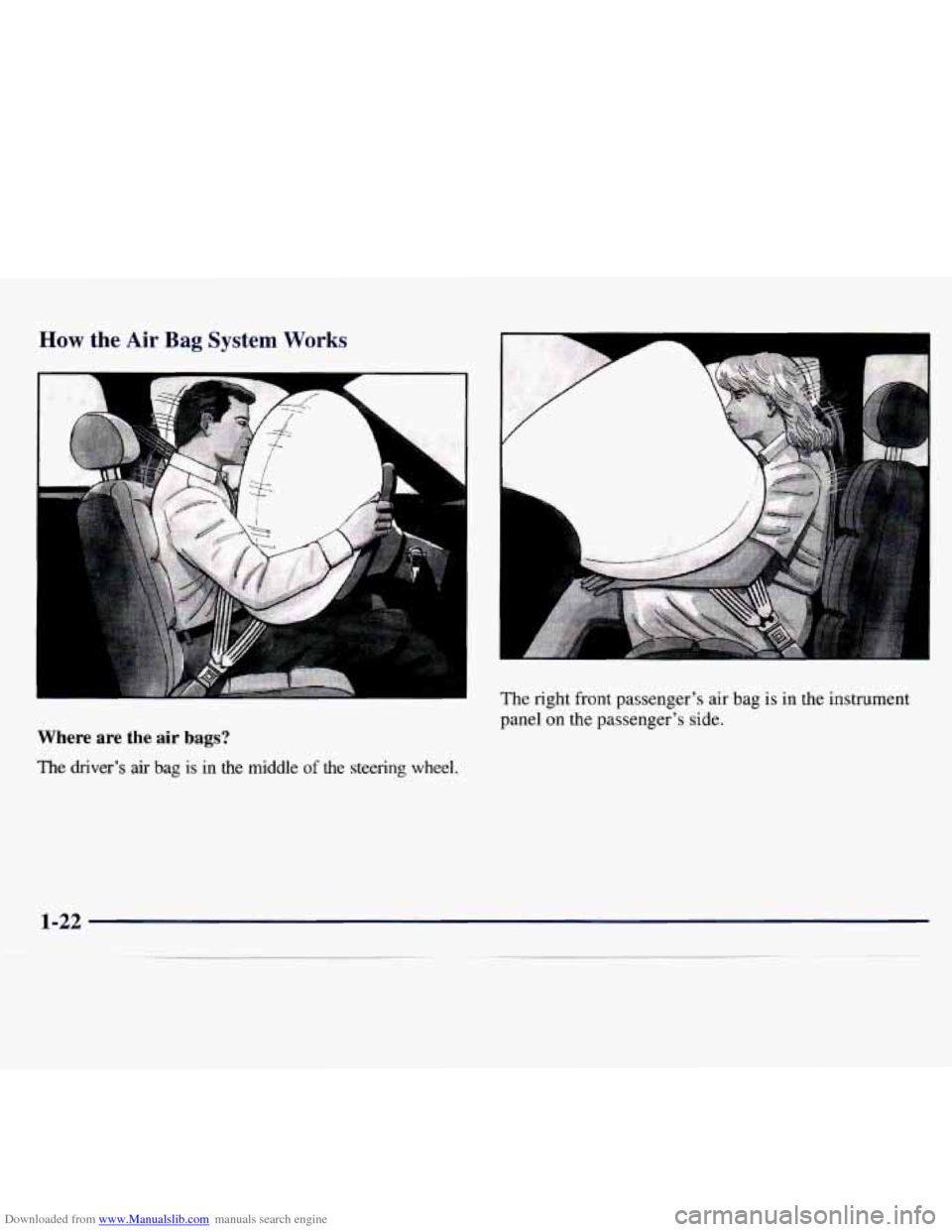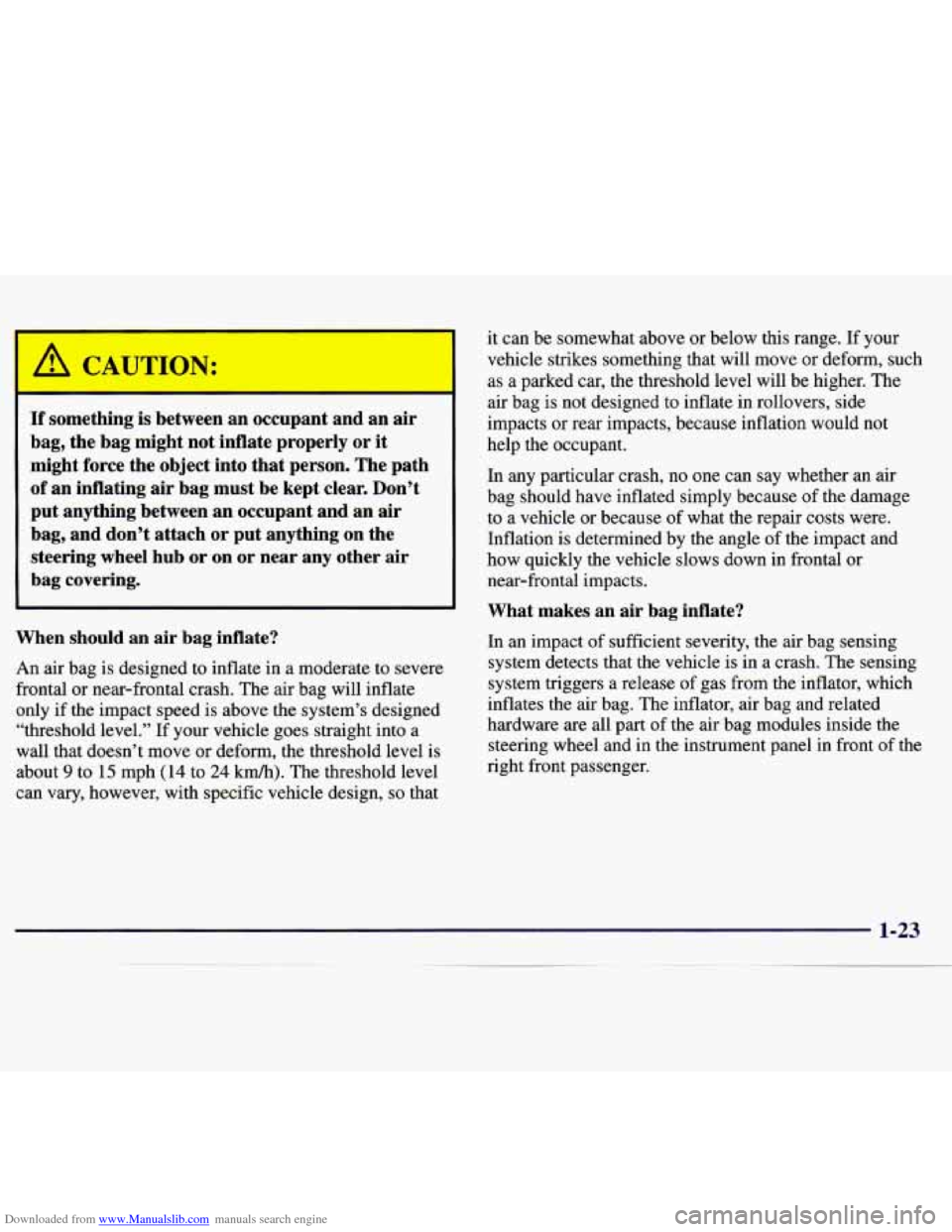1997 CHEVROLET MONTE CARLO steering
[x] Cancel search: steeringPage 12 of 358

Downloaded from www.Manualslib.com manuals search engine This is a correction to information found on page 6-58 and 6-59 for Lumina and Monte Carlo.
Fuse
7
8
9
10
11
12
13
14
15
16
Rating Description
Starter Relay
Not Used
Not Used
VP Electronics Battery -- Chime
Module, Electronic Brake Control
Module (EBCM), Theft-Deterrent
Module, Radio DLC
Power Accessory #2
-- Sunroof Control
Unit,
(S.E.O.) Accessory Feed
Anti-Theft/PCM
-- Theft-Deterrent
Module, Powertrain Control Module,
(PCM)
IGN Syst. Relay
ABS
-- Electronic Brake Control Module
(EBCM), ABS Relay
HVAC Blower Motor
-- Blower Motor
Relay
L.H. Spot Lamp
(S.E.O.)
Steering Wheel Control #1 -- Steering
Wheel Radio Control Lighting
Fuse Rating Description
17
18
19
20
21
22
23
24
25
26
27
Not Used
Not Used
Power Accessory
#1 -- Door Lock
Switches, Trunk Courtesy Lamp,
O/S
Mirror Switch, (S.E.O.) Emergency
Vehicle-Rear Compartment Lid Lamp or
Window Panel Lamps
Steering Wheel Control
#2 -- Steering
Wheel Radio Controls
Air Bag
-- Air Bag System
Cruise Control
-- Cruise Control Cut-Out
Switch, Cruise Control Module, Turn
Signal Cruise Control Switches
Stoplamps
-- Stoplamp Switch (Brake)
Not Used
EnglisWMetric
(S.E.O.)
Not Used
Not Used
3
Page 35 of 358

Downloaded from www.Manualslib.com manuals search engine How the Air Bag System Works
Where are the air bags?
The driver’s air bag is in the middle of the steering wheel. The
right front passenger’s air bag is in the instrument
panel
on the passenger’s side.
Page 36 of 358

Downloaded from www.Manualslib.com manuals search engine If something is between an occupant and an air
bag, the bag might not inflate properly or it
might force the object into that person. The path
of an inflating air bag must be kept clear. Don’t
put anything between an occupant and an air
bag, and don’t attach or put anything on the steering wheel hub or on
or near any other air
bag covering.
When should an air bag inflate?
An air bag is designed to inflate in a moderate to severe
frontal or near-frontal crash. The air bag will inflate
only if the impact speed is above the system’s designed
“threshold level.” If your vehicle goes straight into a
wall that doesn’t move or deform, the threshold level is
about
9 to 15 mph (14 to 24 kmh). The threshold level
can vary, however, with specific vehicle design,
so that it can
be somewhat above or below this range. If your
vehicle strikes something that will move
or deform, such
as a parked car, the threshold level will be higher. The
air bag is not designed to inflate in rollovers, side
impacts or rear impacts, because inflation would not
help the occupant.
In any particular crash, no one can say whether an air
bag should have inflated simply because of the damage
to a vehicle or because of what the repair costs were.
Inflation is determined by the angle of the impact and
how quickly the vehicle slows down in frontal or
near-frontal impacts.
What makes an air bag inflate?
In an impact of sufficient severity, the air bag sensing
system detects that the vehicle is in a crash. The sensing
system triggers a release of gas from the inflator, which
inflates the air bag. The inflator, air bag and related
hardware are all part
of the air bag modules inside the
steering wheel and in the instrument panel in front of the
right front passenger.
Page 37 of 358

Downloaded from www.Manualslib.com manuals search engine How does an air bag restrain?
In moderate to severe frontal or near-frontal collisions,
even belted occupants can contact the steering wheel or the
instrument panel.
Air bags supplement the protection
provided by safety belts. Air bags distribute the force of the impact more evenly over the occupant’s upper body,
stopping the occupant more gradually. But air bags would
not help you in many types of collisions, including
rollovers, rear impacts and side impacts, primarily because
an occupant’s motion is not toward those air bags. Air
bags should never be regarded as anything more than a supplement to safety belts, and then only in moderate to
severe frontal or near-frontal collisions.
What will you see after an air bag inflates?
After an air bag inflates, it quickly deflates, so quickly
that some people may not even realize the air bag
inflated. Some components of the air bag module in the
steering wheel hub for the driver’s air bag, or the
instrument panel for the right front passenger’s bag, will
be hot for a short time. The parts of the bag that come
into contact with you may be warm, but not
too hot to
touch. There will be some smoke and dust coming from
vents in the deflated air bags. Air bag inflation doesn’t
prevent the driver from seeing or from being able to
steer the vehicle, nor does it stop people from leaving
the vehicle.
When an air bag inflates, there is dust in the air.
This dust could cause breathing problems for
people with a history of asthma or other
breathing trouble.
To avoid this, everyone in the
vehicle should get out as soon as
it is safe to do so.
If you have breathing problems but can’t get out
of the vehicle after an air bag inflates, then get
fresh air by opening a window or door.
In many crashes severe enough to inflate an air bag,
windshields are broken by vehicle deformation.
Additional windshield breakage may also
occur from the
right front passenger air bag.
Air bags are designed to inflate only once. After they
inflate, you’ll need some new parts for your air bag
system. If
you don’t get them, the air bag system
won’t be there to help protect you in another crash.
A new system will include air bag modules and
possibly other parts. The service manual for your
vehicle covers the need to replace other parts.
Page 38 of 358

Downloaded from www.Manualslib.com manuals search engine 0
0
Your vehicle is equipped with a crash sensing and
diagnostic module, which records information about
the air bag system. The module records information
about the readmess
of the system, when the sensors are
activated and driver’s safety
belt usage at deployment.
Let only qualified technicians work on your
air bag system. Improper service can mean that
your air bag system won’t work properly. See your
dealer for service.
NOTICE:
If you damage the covering for the driver’s or the
right front passenger’s
air bag, the bag may not
work properly.
You may have to replace the air
bag module in the steering wheel or both the air
bag module and the instrument panel for the
right front passenger’s air bag.
Do not open or
break the
air bag coverings.
Servicing Your Air Bag-Equipped
Chevrolet
Air bags affect how your Chevrolet should be serviced.
There are parts of the air bag system in several places
around your vehicle. You don’t want the system to
inflate while someone is working on your vehicle. Your
Chevrolet dealer and the Monte Carlo Service Manual
have information about servicing your vehicle and the
air bag system.
To purchase a service manual, see
“Service and Owner Publications”
in the Index.
For up to 10 minutes after the ignition key is
turned off and the battery is disconnected, an air
bag can still inflate during improper service. You
can be injured
if you are close to an air bag when
it inflates. Avoid wires wrapped with yellow tape
or yellow connectors. They are probably part of
the air bag system. Be sure to follow proper
service procedures, and make sure the person
performing work for you is qualified to do
so.
The air bag system does not need regular maintenance.
Page 60 of 358

Downloaded from www.Manualslib.com manuals search engine 0 Section 2 Features and Controls
Here you can learn about the many standard and optional features on your Chevrolet, and information on starting,
shifting and braking. Also explained are the instrument panel and
the warning systems that tell you if everything is
working properly -- and what to do if you have a problem.
2-2
2-4
2-5
2-8
2-9
2-10
2-12 2-12 2-13
2-15
2-16
2-20
2-2
I
2-24
2-24
2-25
2-25
Keys
Door Locks
Remote Keyless Entry (If Equipped)
Trunk
Theft PASS-Key@ I1
New Vehicle “Break-In”
Ignition Positions
Starting Your Engine
Engine Coolant Heater (Option)
Automatic Transaxle Operation
Parking Brake
Shifting Into PARK
(P)
Shifting Out of PARK (P)
Parking Over Things That Burn
Engine Exhaust
Running Your Engine While You’re Parked
2-26
2-27
2-27 2-27
2-33
2-35
2-36
2-3 8
2-40
2-40
2-42
2-43
2-44
2-46
2-48
Power Windows
Horn
Tilt Steering Wheel
Turn SignaVMultifunction Lever
Exterior Lamps Interior Lamps
Mirrors Storage Compartments
Ashtrays and Lighter
Sun Visors
Auxiliary Power Connection
Sunroof (Option)
Instrument Panel
-- Your
Information System
Instrument Panel Cluster
Warning Lights, Gages and Indicators
Page 68 of 358

Downloaded from www.Manualslib.com manuals search engine Trunk Lock
To unlock the trunk from
the outside, insert the door
key and turn it. You can
also use the remote keyless
entry function if your
vehicle has this option.
Just press the trunk symbol
on the transmitter, making
sure your shift lever is in
PARK
(P).
Remote Trunk Release (Option)
Press the button under the
instrument panel on the
driver’s side. Your transaxle
shift lever must be in
PARK (P).
Remember, your trunk can be opened at any time using
this lock release,
so be sure to lock your doors.
Theft
Vehicle theft is big business, especially in some
cities. Although your Chevrolet has
a number of
theft-deterrent features, we know that nothing we put
on it can make
it impossible to steal. However, there are
ways you can help.
Key in the Ignition
If you leave your vehicle with the keys inside, it’s an
easy target for joy riders or professional thieves
-- so
don’t do it.
When ydu @ark your Chevrolet and open the driver’s
door, you’ll hear a chime reminding you to remove your
key from the ignition and take it with you. Always
do
this. Your steering wheel will be locked, and so will
your ignition and transaxle. And remember
to lock
the doors.
Page 71 of 358

Downloaded from www.Manualslib.com manuals search engine New Vehicle “Break-In” Ignition Positions
NOTICE:
Your modern Chevrolet doesn’t need an
elaborate “break-in.” But
it will perform better
in the long run
if you follow these guidelines:
0
0
0
Don’t drive at any one speed -- fast or
slow
-- for the first 500 miles (805 km).
Don’t make full-throttle
starts.
Avoid making hard stops for the first
200 miles (322 km) or so. During this time
your new brake linings aren’t yet broken
in. Hard stops with new linings can mean
premature wear and earlier replacement.
Follow this breaking-in guideline every
time
you get new brake linings.
Don’t tow
a trailer during break-in.
See “Towing a Trailer” in the Index for
more information.
A 1 E
With the ignition key in the ignition switch, you can turn
the switch to five positions:
ACC (A): This position lets you use things like the
radio and windshield wipers when the engine is
off. To
use ACC, push in the key and turn it toward you. Your
steering wheel will stay locked.
LOCK (B): Before you put the key into the ignition
switch, the switch is in
LOCK. It’s also the only position
in which you can remove your key. This position locks
your ignition, steering wheel and transaxle. It’s
a
theft-deterrent feature.